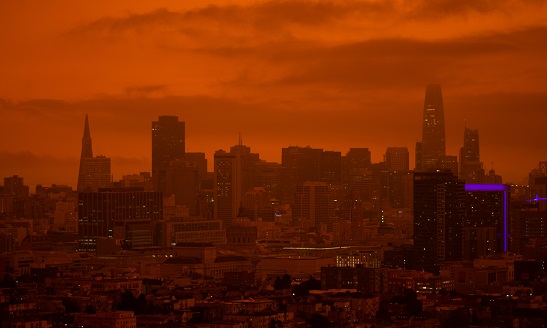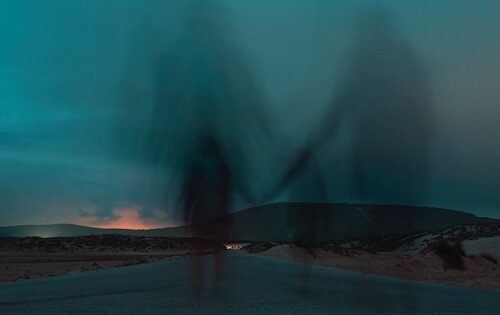
Book Spotlight | The Son of Abraham by Kathleen Kaufman
Today the spotlight is on The Son of Abraham by Kathleen Kaufman!
This is the heart-wrenching last installment to the Diabhal series which features elements of dark fantasy with occult end-of-days terror. The book is out today in digital, physical and audio. Thank you to Turner Publishing for a review copy!
I’m sharing the official synopsis and a guest post by the author herself, Kathleen Kaufman, where she discusses women’s representation in dystopian literature. Check it out below!
This post contains affiliate links. I receive a commission if you decide to make a purchase through my links, at no cost to you.

Genre: Horror/Dark Fantasy
Page Count: 288 pages
Publication Date: 26 October 2021
Author: Bryce Moore
Publisher: Turner Publishing
Synopsis
Ten years after the city of Los Angeles is nearly destroyed by a violent domestic terrorist attack, Esther Robertson struggles to reconcile her father’s culpability as leader of the deadly Son of Abraham cult. She grants CBS’s top reporter, Cooper Carlson, a rare interview and insight into her father, Alan Robertson, who sits awaiting trial for his crimes in federal prison.
A report of a horrific and seemingly natural disaster interrupts the interview. Another will follow and another after that. Are these increasingly violent and bizarre phenoms truly natural, or is there another force behind them?
In the epic conclusion of the story of the Society at Sinder Avenue, the end times–put into motion by a demonic deal made generations ago–are finally unfolding. Destruction, famine, war, and pestilence reign. But is it God who comes to answer the prayers of the suffering and dying world, or is it Ceit Robertson, the ascended matriarch of the Society, Goddess of the Dead, and Ruler of the Night Forest? Will they offer salvation or Armageddon?
Guest Post by Kathleen Kaufman
Dystopia is our way to play out the end of the world but not actually stare the end of the world in the face. It’s much the same appeal that True Crime holds, a chance to walk our way through a scenario without actually having to experience it. The real question is what does that say about us and who we are?
It’s a tricky genre for female characters, but it’s getting better all the time. No longer are women relegated to being nameless mothers, wives, daughters. Women are more and more often taking center stage and commanding attention. Here are just a few of the roles women hold in the dystopian genre.
The Exceptional:
One of the most enigmatic roles in Dystopia for female characters goes to the Exceptional. The girl who has a talent, skill, destiny far beyond that of anyone else. The one who, without any apparent training or special tools, rises above her peers and eventually leads her colony, band, group, or family to a happily ever after. The Exceptional feeds into our internal fantasies that we are not like the rest of these suckers, we’re special, we’re smarter, more talented, different. What is happening to them, would never happen to us. It’s an attractive fantasy, if somewhat disconnected from reality most of the time.
Lauren Olamina in Octavia Butler’s classic The Parable of the Sower, is blessed with ‘hyper-empathy’ or the ability to physically and emotionally feel anything that another experiences. This is the core of her teachings, and eventually what brings others to follow her.
Melanie from Mike Carey’s The Girl With All The Gifts is a bit different, she isn’t quite human…she’s just a little bit zombie, but even with that presumed handicap, she rises above the expected.
The Survivor:
The Survivor might be a little exceptional, and she might be a little of a badass, but mostly, she’s just learned the rules of the game she’s been forced to play. In fact, she’s learned them so well, that she can bend and twist those rules to her liking, and in doing so, changes the game entirely. Easily my favorite female dystopia role, the Survivor is any one of us, she might be entirely ordinary if life had left her alone, but now that it decided to mess with her? Well, stand back.
Katniss Everdeen from Suzanne Collins’ Hunger Games trilogy is a prime example of the Survivor. She has a talent with a bow, sure, but once she enters the arena, her fighting skills aren’t any greater than anyone else’s, and considerably lesser than some. Her skill comes from recognizing the wheels within wheels that operate in the Capital, and knowing exactly how to disrupt the cycle.
Offred aka June Osbourne come to us from Margaret Atwood’s The Handmaid’s Tale. In the original text, Offred has no name other than given to her by Gilead. June Osbourne is a creation of the Hulu series, which was governed by Atwood and designed with her guidance. June is a quintessential survivor, she is no more intelligent, brave, or skilled than any of the other handmaids, but she does have an uncanny knack for observation and grit. She perseveres, she waits patiently, and she manages to infiltrate the Waterford household undo Gilead from within.
The Badass:
The Badass is all fire and venom. However she came to that place, by the time the stuff started to hit the dystopian fan, the Badass already had her flamethrower and machete ready to go. We’d all hope we’d be the Badass, the fearless warrior that runs into the danger rather than away. And maybe we all suspect we wouldn’t be…at least not all the time.
Thus, the attraction of characters like Mad Max’s Imperator Furiosa. A one-armed, truck driving Badass who risks her life to save Immortan Joe’s unfortunate captives. She borders on the Exceptional except Furiosa’s skills were not gifted to her at birth, rather they were forged in fire. She earned every muscle, every drop of sweat, every scar.
Carol Peletier from Robert Kirkman and Tony Moore’s The Walking Dead is perhaps better known from the AMC series. Carol starts off as a battered wife and ends up torching Terminus with a flamethrower. She is repeatedly the toughest one in whatever scene she appears in, and my prediction for the last one standing in the series overall.
The Victim:
But the dystopia genre wouldn’t be complete without a few wilting violets to save. Not all the female characters in dystopias can be fighters, some have to be saved. Cue the Victim. Tossed and thrown by life’s slings and arrows, the victim is barely keeping her head above water until a strong, usually male, character swoops in and pulls her to shore. She might have a redemption arc wherein she learns to survive on her own and even stand on her own two feet, but she’ll always need a little rescuing. I really hope that when the dystopia hits, this isn’t me. However, given my utter lack of fighting or survival skills…yeah, well, I shouldn’t be too quick to judge the Victim.
Rhine Ellery comes to us from Lauren DeStefano’s The Chemical Garden trilogy. Rhine is kidnapped at age sixteen, and sold off to the wealthy Linden as one of his three brides. A dystopian universe where everyone is dead by age twenty-five, Rhine spends her time lamenting her fate until handsome serving boy Gabriel helps her escape Linden’s castle. It’s all dreadfully romantic and sweeping, and utterly addictive, I loved this trilogy even if I did keep rooting for Rhine to find a flamethrower and torch the place to the ground at some point.
Stephen King brings us Frannie Goldsmith in his epic The Stand. The Stand is long seen as the quintessential dystopian classic, and as such, it prominently displays many of the tropes that appear in dystopias that have followed. Frannie is left alone, pregnant, and utterly lost as to what to do. She follows Harold out of Maine, then gratefully allows West Texas’ Stu to protect her. I like Frannie, I do. But apart from immunity to the flu, she is less than exceptional. She has the good sense to stay away from Harold, but relies on Stu for survival. Her badassness is muted as she’s relegated to the role of the mother early on.
The Son of Abraham is a dystopian story that pays homage to many of its predecessors. It would be irresponsible not to. In writing this third, and last, installment of the Diabhal trilogy, I reached back into my mental storeroom and used the collective knowledge and experience from Octavia Butler, Margaret Atwood’s, Lauren DeStefano, Stephen King, Mike Carey, and so, so many others. Esther Robertson is the survivor of a deadly terrorist attack that destroyed Los Angeles. Ten years later, she gives a rare interview to media hotshot Cooper Carlson, and a new cycle of terror begins.
Esther is crippled by survivor’s guilt, she hides from the light and recognition of her infamy. As she rushes to stop her father’s destruction, she is neither exceptional, nor a victim, rather, she’s a young woman who has lived with the weight of a thousand souls on her back for a decade. She is any one of us who struggle to move on from the past, who feels trapped by the actions of those that came before us. She’s a survivor, not because she has learned the rules of the game, but because she refuses to accept them.
In writing Esther, I channelled Lauren and Melanie’s otherworldly talents to fuel Esther’s ability to transcend to the Night Forest ruled by the Bandia Marbh, the Ruler of the Dead. I imbued her with Katniss and June’s knack to stay alive, even when circumstance made that option seemingly impossible. I injected just enough Furiosa and Carol to make Esther a force to be reckoned with, to make her anger palpable and dangerous to those who dare to tread in her garden. And because they exist in all of us, Esther carries Rhine and Frannie as well. She needs help, and sometimes she needs to be saved, if only from herself.
Perhaps the reason dystopia remains relevant is because of its ability to showcase the different faces of humanity, and our ability to deal with the undealable. It gives us hope that whatever we’re facing in our waking lives, it isn’t as bad as all that. We don’t live in Gilead after all, right? Our boss might be terrible but he’s no Immortan Joe, is he? Apart from the small comforts of comparison though, dystopia shows us that we’re stronger than we admit to being. Maybe if we read, and watch, and listen enough….we’ll find our inner Furiosas.
Cover photo by Patrick Perkins






